This post is also available in:
 English
English  Italiano (Italian)
Italiano (Italian)  Русский (Russian)
Русский (Russian)
How to choose an under-the-sink drinking water filter (purifier)?
What is the difference between flow filters for drinking water?
What is the difference between the cartridges used in Aquaphor Crystal systems?
What should you pay attention to when using a flow-through filter?
Frequently asked questions from buyers and users of Aquaphor Crystal water purifiers.
The article examines and compares various types of household flow-type drinking water filters for installation under the kitchen sink or counter, their differences, and their advantages.
In one of the previous articles, we looked at various devices and systems for the purification of drinking water. We have made sure that even “potable” tap water, which meets basic standards, should be purified – for safety and comfort purposes.
In another article, we showcased different reverse osmosis filtering systems, which have the most perfect degree of purification (about 99.9%). Now we will examine flow-through filtration systems – simple, but quite effective.
Update:
We’ve got some great news! While this current article is still useful and accurate, Aquaphor has made some amazing upgrades to its product range in 2024. We’ve been lucky enough to get our hands on the new and improved Aquaphor Crystal series, and we’re excited to share our findings with you here, in a new interesting article !
As you know, a characteristic element of any reverse osmosis system is a membrane that retains most of the insoluble and water-soluble elements, passing (ideally) only water molecules. However, this method also has disadvantages. Firstly, for the stable operation of the membrane, careful preliminary filtration of water through conventional filters and sufficiently high pressure in the water supply system are required. In addition, when using this technology, more water goes to the drain than filtered – on average, 3-4 liters per 1 liter of filtered water are drained during operation. The osmosis process itself is rather slow and, as a consequence, requires the use of additional elements – a storage tank and a post-filter.
Therefore, if the source water, in general, is safe, suitable for consumption, and does not have excessive hardness and mineralization, in many cases it is more rational to use simpler classical flow filters (microfiltration systems). These filters have one input and one output; in this way, all water passing through the system is filtered and used. Consequently, no drainage is required and water is consumed more economically. An additional advantage of flow-through filters is that such filters operate in a wider range of initial pressure in the water supply system and are easier to install. At the same time, they have a sufficient degree of filtration, are effective against chlorine, lead, heavy metals, pesticides, phenol, colloidal iron, microplastics, and other harmful impurities of small size. Flow filters, which include the element of activated carbon, perfectly eliminate foreign odors and improve the taste of water.
Classical Reverse Osmosis Home System with prefilters of 10-inch standard.
Flow-through filters for water purification differ in the number of stages (phases) of cleaning and in their design. The most common are three-stage filters. As a rule, the first filter provides initial mechanical water purification from solid impurities and is made of food-grade polypropylene. The second filter is usually selected based on the characteristics of the source water and can be, for example, standard or softening. As the third filter, a finely dispersed carbon block is often used, which absorbs foreign odors and tastes.
In terms of design, just 10-20 years ago, home flow filters were usually scaled-down copies of industrial filters. They looked like a series of round containers (glass-like housings) connected in series with each other. Currently, filters of this type (for “drop-in” cartridges) are still produced. Their round containers hold replaceable filters of one of the standard sizes, most commonly 2.5 “x 10”. It is not very easy to change such filters, because you have to unscrew the containers from the body, and the large-diameter thread is tough.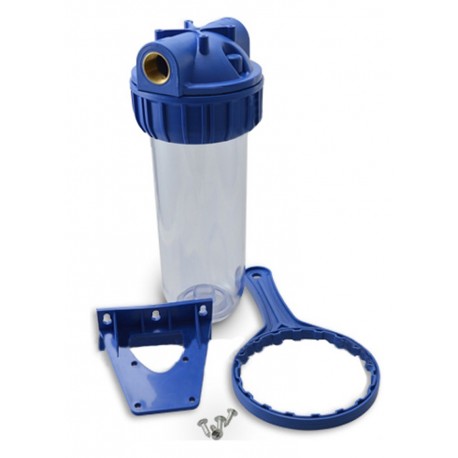
Typical conventional flow filter container for filters 2.5 “x 10”
However, now there are devices that are more compact and easy to use.
In particular, manufacturing companies have paid attention to the convenience of replacing filter elements. At first, bayonet filters appeared instead of the usual screw-on containers. Then Aquaphor developed an even easier replacement method with minimal time and effort – the Click-And-Turn fastening technology. One of the filter systems using this technology is the line of flow filters Crystal.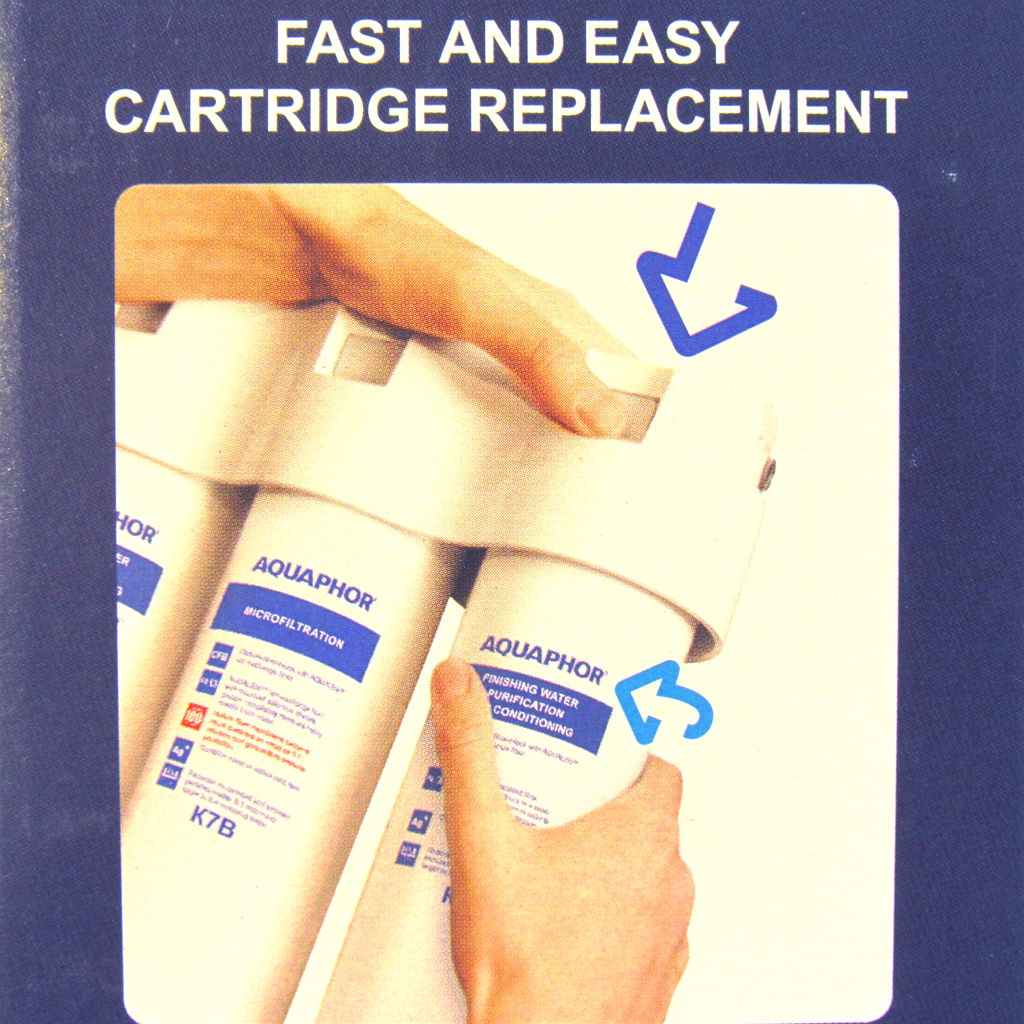
Aquaphor Crystal Push And Turn Technology
Modern compact filters of the Aquaphor Crystal family not only perfectly and quickly purify water, but also, thanks to the use of innovative technologies, are the most convenient and easy to use among other household filters.
Their replaceable filters last much longer than conventional systems, due to the increased amount of adsorbent and its regular structure. The frequency of replacement of elements depends on the quality of water at the inlet to the filter, but, on average, replacement is required after filtration 6000-8000 liters.
The applied modules Carbon-Fiber-Block (CFB) are made from natural coconut charcoal using Aqualen ion exchange fiber. With its help, the thickness of the capillaries of the passage of water is stabilized. At the same time, the contact area of water and sorbents becomes 42 times larger than that of conventional granular carbon filters, and the filtration rate is four times higher.
Standard carbon sorbent (left) vs Aquaphor Aqualen composition (right)
The Crystal system is also superior to other brands because filter replacement has become much easier, thanks to special fasteners that require minimal effort and time (Click-And-Turn or Push & Turn technology). In addition, the filters are replaced along with the housings. Yes, this increases a bit the cost of replacement elements, but this approach has many advantages. Replacing such a cartridge can take less than a minute without the use of special tools; there is no need to disassemble, rinse and disinfect the housings (containers), and the possibility of human contact with contaminated filter elements and surfaces is prevented.
The whole system is a compact mono-block that needs very little space under the kitchen sink.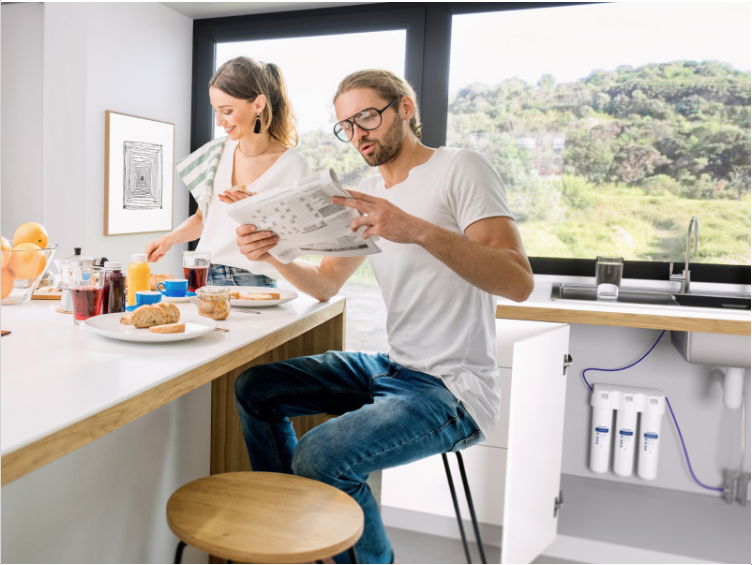
Crystal System in the kitchen
The most popular models of the Aquaphor Crystal family are:
Crystal is a universal system for a wide range of applications;
Crystal H is a system with a cartridge softener for hard water;
Crystal A is an inexpensive filter that fights well against common urban tap water contaminants;
Crystal HA is a variation of the Crystal A system, in which a softener cartridge for hard water is used as the second element;
Crystal ECO – is the flagship model, which uses the K7B cartridge with a porosity of 0.1 micron, which allows you to retain most bacteria and large viruses; in addition, this model is equipped with a more solid and durable tap for purified water.
In fact, the main difference between Crystal systems is the used cartridges. Thus, when the time comes to replace the filter elements, you can easily turn your model into a more advanced one (make an upgrade).
The table below gives an idea of the filter sets used in a particular model.
The sequence of installation of filter cartridges: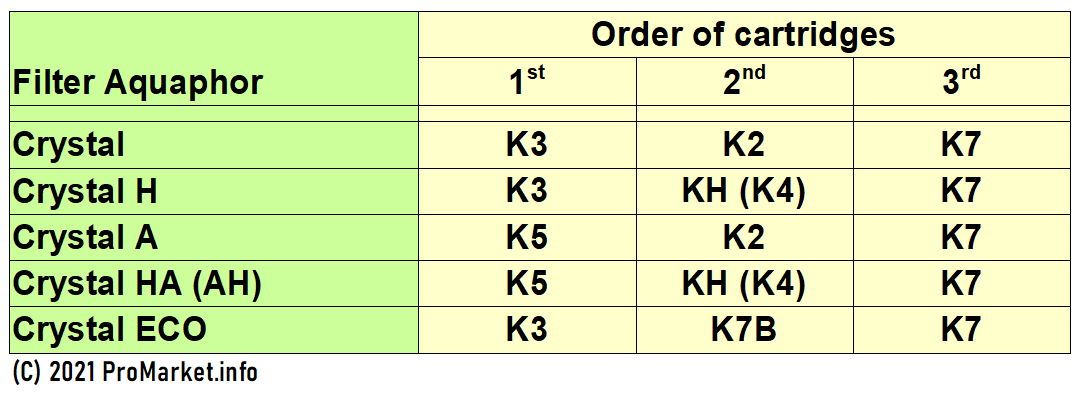
K3 – element of the first stage of cleaning; it is a carbon fiber filter block (CFB) that combines sorption cleaning and mechanical filtering of particles larger than 10 microns; it contains silver in an active ionic form, which provides a bacteriostatic effect.
K5 – element of the first stage of cleaning; it is a mechanical filter made of food-grade polypropylene with a porosity of 5 microns; cleans water from the most common impurities such as rust, sand, and silt.
K2 – element of the second stage of cleaning; it is a carbon fiber filter (CFB) that combines deep sorption cleaning and mechanical filtration from particles larger than 3 microns; removes harmful impurities, incl. suspended matter, chlorine, heavy metals, and organic matter; contains silver in an active ionic form, which provides a bacteriostatic effect.
KH (K4) – element of the second stage of cleaning; softens hard water, solving problems of scale and flakes in boiled water; can be regenerated at home with table salt.
K7B – element of the second or third stage of cleaning; consists of two components in one housing: a carbon fiber filter (CFB) that combines deep sorption cleaning and mechanical filtration from particles larger than 3 microns, and a hollow fiber membrane that traps microparticles larger than 0.1 microns and provides protection against bacteria; contains silver in an active ionic form, which provides a bacteriostatic effect.
K7 – element of the third stage of cleaning; is a super-dense carbon block made of natural powdered activated coconut carbon (CFB) for final cleaning (with a porosity of 0.8 microns), which completely removes even the smallest amounts of harmful impurities; contains silver in an active ionic form, which provides a bacteriostatic effect.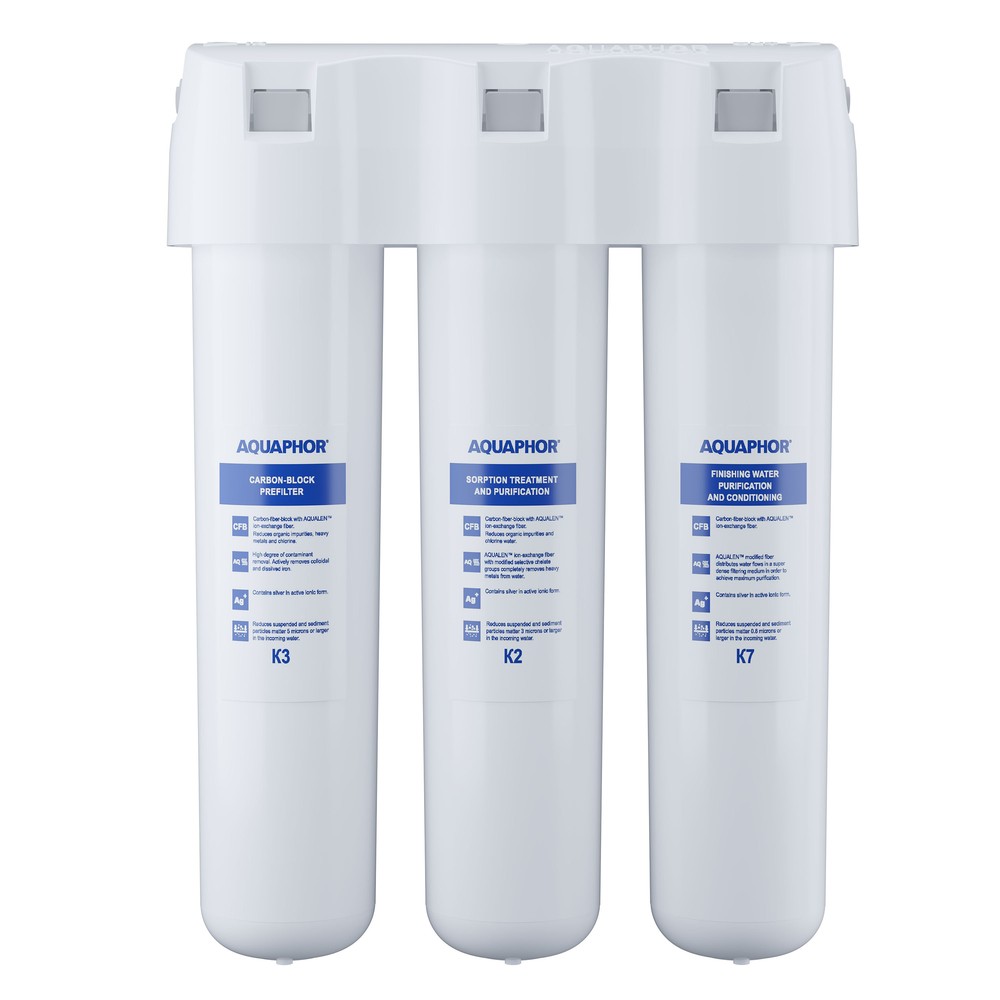
There is no simple answer to the question “Which flow filter is better?” Since a lot depends on its operating conditions. Therefore, above we tried to compare different types of these filters and find out how to choose the most suitable one for each case.
From a practical point of view, it is best to first find out the shortcomings of the source water, and then focus on the characteristics of the elements (cartridges) included in the set. For example, if the water is generally safe, but has some disadvantages, such as fine sand particles or small traces of rust from the plumbing, you can use Crystal or even the cheaper Crystal A. If the water is too hard, which creates white bloom and flakes after boiling, you can soften it with the Crystal H or Crystal HA system. If there is a suspicion that bacteria may be present in the water, it is better to install an ultrafiltration system like Crystal ECO.
In addition, you should focus on the taste and properties of filtered water and drinks prepared with it (tea, coffee). Fortunately, in the case of Crystal filters, you can adjust the set of filters at any time, experiment a little and find the best option.
• If you use conventional modules for the post-treatment of hard water, then white sediment or a surface film of hardness salts may appear in the filtered water. This is not due to a malfunction of the water purifier. For water softening, you can use replaceable filter modules KH (K4).
• If the source water has a high hardness (more than 7 meq / l), then after softening it can acquire a slight salty taste. This is due to the exchange of calcium ions for sodium ions, which does not indicate a malfunction of the water purifier and does not harm your health. If the hardness is even higher, then it is better to use a reverse osmosis system.
• If you have not used your water purifier for more than a week, run water through it for at least 5 minutes. After installing new cartridges, be sure to flush the system according to the instructions (usually at least 20 minutes).
If you doubt the bacterial or viral safety of the source water, then after filtration, the drinking water must be boiled anyway.
• Purified water is not subject to long-term storage. Use only freshly filtered water. A small amount of filtered water can be stored in the refrigerator for 1-2 days. If you want to keep the water longer, boil it additionally.
• When transporting, storing and using the filter modules, protect them from impacts and falls, as well as from water freezing in them.
• Dispose of used modules in accordance with the environmental, sanitary, and other requirements established by national standards in the field of environmental protection and ensuring the sanitary and epidemiological well-being of the population.
Unlike some other manufacturers, Aquaphor does not transfer its production to the “third world” countries. The main factories of Aquaphor are in Europe and the USA. The European market mainly receives products from the new production plant in Estonia. These products are manufactured to the highest quality standards and comply with all EU regulations. You can purchase filters, filter cartridges, and related products in the online store Promarket-EU.
It may be convenient for those who have an Amazon account to order goods at any of the European branches of this online platform. Relevant links for buyers from the UK, Italy, France, Germany, Spain, and other European countries can be found on the portal.
If you have a related business (for example, a store for household goods and household appliances, a pharmacy, or a business for plumbers), you can offer your customers a new high-quality, and profitable product. For wholesale discounts and sales representative deals, please write to ProMarket by e-mail. 
Installing the Crystal filter is easy. It is necessary to find a place to install the filter itself, establish a faucet for purified water on the sink and connect the inlet of the water purifier to the pipeline. All main connectors and flexible tubes are included. If your plumbing needs an extra adapter, you can usually find one at your local hardware store.
Installation instructions in English and Italian are included.
Typically, the entire process of installing a water purifier takes no more than 1 hour.
Video instructions for installing a series Crystal of water purifiers under the sink:
https://youtu.be/FnfktHbo1IQ
https://youtu.be/7l2I1cu7GWc
Horizontal installation is not provided by the manufacturer. Installation must be done vertically, in accordance with the instruction manual (supplied with the purifier in English and Italian).
There are 2 reasons:
1) water cartridges are heavy when filled, their fastening will be subjected to more stress (lever effect) and may break or deform;
2) water inlet and outlet are at the top of the cartridge coaxially. If the cartridge is placed horizontally, dirty water will come out when replacing the cartridges.
Usually yes. But it makes sense to make sure the faucet has a potable water hose/fitting that fits the 1/4″ JG hose of the purifier (John Guest LLDPE, 6.35mm diameter).
Otherwise, a suitable adapter can be found at a hardware store.
P.S. Please note that the Aquaphor Crystal series always includes a separate tap for drinking water (as in the photo).
If the source water has a high hardness (above 5 meq/l), after softening it may have a slightly salty taste. This is due to the exchange of calcium ions with sodium ions. This is normal, and not harmful to health. A flow filter (for example, Aquaphor ECO) removes only impurities, not dissolved salts. Cartridge mineralizer K7BM enriches water with magnesium and calcium ions. This slightly changes the taste of the water but does not greatly reduce the salt content. Theoretically, you can set it to place 2 or 3. Whether you like the result, we cannot know: tastes are tastes …
Salinity can only be completely eliminated with a reverse osmosis filter. You can also ask a plumber to connect the Crystal to a water source before the water softener, if possible.
If you have installed an Aquaphor Crystal, Crystal A or Crystal ECO filter, proceed as follows:
1) Adjust the water flow rate according to the recommended filtration rate (2.0 – 2.5 l / min) using the connection block;
2) Let the water pass through the filters for 10 minutes;
3) Close the clean water tap and wait 10 minutes;
4) Run the water through the filters for 50 minutes.
So, for the launch procedure, you need to drain about 2 * 60 = 120 liters.
For Crystal H or Crystal AH (with KH softener cartridge), the instructions are slightly different. We always include detailed user manuals in English and Italian. Just follow them.
Even after this, the water may not be visually clear due to very small air bubbles. This is fine. Usually, all the air is expelled from the filter by the water stream after 1-2 days.
If you have sediments that form on the water after boiling (limescale), it most likely means that the water is hard (it contains calcium salts). Usually, these salts are not harmful to health, although they spoil the appearance and taste of tea and coffee. If there are too many of them, then in this case it is recommended to use Crystal filters, which include a softening cartridge – KH (K4). These are: Crystal H and Crystal HA.
You can check the water hardness level with the Titrant kit.
You can completely eliminate the effect of hard water only with the help of a reverse osmosis system, for example, Aquaphor Morion DWM-101S or RO-50.
Frequently asked questions from buyers and users of Aquaphor Crystal water purifiers.
Photos and technical details courtesy of Aquaphor, ProMarket.
Other helpful information:
If you own a related business (for example, a store selling household goods and appliances, a pharmacy, or a plumbing company), you can offer your customers a new high-quality, profitable product.
Please email ProMarket for wholesale discounts and sales representative offers.
Special offer for a plumber
Special offer for a hardware store
Special offer for a pharmacy
RELEVANT VIDEOS
First unboxing of Aquaphor Crystal A new version 2024:
Video instructions for installing a series Crystal of water purifiers under the sink:
(C) 2021-2024 Promarket.info: Quoting, reprinting and reproduction (in whole or in part) are permitted only with the name of the website Promarket.info and the full hyperlink to this page.
This post is also available in:
 English
English  Italiano (Italian)
Italiano (Italian)  Русский (Russian)
Русский (Russian)

